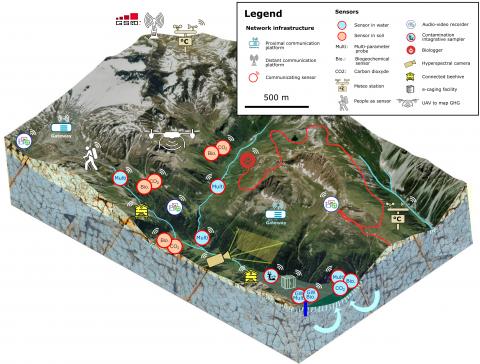Terra Forma, sensors to meet environmental challenges
The Terra Forma project aims to deploy a large network of environmental sensors to understand the transformations linked to climate change in pilot areas. Led by the CNRS, this open source and economical sensor project aims to obtain keys to understanding environmental changes in order to better adapt to them. Launched on January 24, 2022, this project brings together various French and Toulouse laboratories, including IRIT. The laboratory is involved through the work of several members, including Rahim Kacimi, responsible for WP 3.2 “Central Platforms” particularly focused on IoT gateways with Multiple-access Edge Computing. The Terra Forma project wishes to involve citizens in the project, so that everyone can be an actor of this scientific project.
What is the Terra Forma project?
According to the CNRS, Terra Forma is an equipment project structuring research (Equipex – Equipements d’Excellence) that stems from the PIA 3 (National Investment Plan for the Future). It aims to change the angle and method in the observation strategy of anthropized natural systems. To this end, it uses two levers identified by the scientific community to transform the current tools and methods of observation: the use of interdisciplinarity and the deployment of a holistic approach, at a scale relevant to research and territorialized action. The project is funded by the ANR to the tune of 9.6 million euros.
The Terra Forma project was born of a global observation. The Earth’s habitability is being modified by the climatic upheavals we are experiencing, such as intensive agriculture that is destroying forests, soil artificialisation, water pollution and the transformation of natural environments that threaten biodiversity. The period of time in which these upheavals are taking place is called the Anthropocene and corresponds to a tipping point where humans are outpacing geological forces. To address these issues, the Terra Forma project has chosen a global approach to understand the interactions and processes that impact the entire system. The network of sensors deployed by Terra Forma in the pilot territories will allow the collection of a large amount of data, the aim of which is to cross-reference points of view and to implement environmental trajectories.
Innovating to adapt to environmental issues
The scientists have chosen to rely on two axes to carry out this project. The first is to work with innovative, open source and low energy technologies and the second is to set up a communication infrastructure capable of processing online the information collected by the sensors. The project leaders have chosen to rely on the most recent technologies in terms of engineering, systems and information sciences. New sensors offer powerful measurement capabilities and artificial intelligence and 3D printing provide solutions to reduce the energy consumption of materials, to extract relevant information quickly and to reduce production costs. The objective is to ensure low energy consumption, to develop embedded intelligence to ensure the relevance of information, to miniaturize sensors and to achieve a competitive cost. The aim is also to achieve a low environmental impact and to ensure the social appropriation of these technologies.
One of the major challenges of the Terra Forma project is the transmission of data collected by the sensors deployed in the territories. This data must be transmitted in near-real time to the servers, and for this, the project calls on innovation and research related to the IoT, the Internet of Things. These innovations have for application domains autonomy, energy recovery, integration of embedded data processing functions (artificial intelligence) and network interoperability. All these innovations allow to couple the technical aspect with the social aspect, whose goal is to produce a transition towards more intelligent networks and towards more resilient and sustainable ecosystems.
